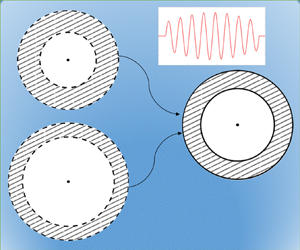Article contents
Radial dynamics of an encapsulated microbubble with interface energy
Published online by Cambridge University Press: 06 December 2021
Abstract

In this work a mathematical model based on interface energy is proposed within the framework of surface continuum mechanics to study the dynamics of encapsulated bubbles. The interface model naturally induces a residual stress field into the bulk of the bubble, with possible expansion or shrinkage from a stress-free configuration to a natural equilibrium configuration. The significant influence of interface area strain and the coupled effect of stretch and curvature is observed in the numerical simulations based on constrained optimization. Due to the bending rigidity related to additional terms, the dynamic interface tension can become negative, but not due to the interface area strain. The coupled effect of interface strain and curvature term observed is new and plays a dominant role in the dominant compression behaviour of encapsulated bubbles observed in the experiments. The present model is validated by fitting the experimental data of  $1.7\,\mathrm {\mu }$m,
$1.7\,\mathrm {\mu }$m,  $1.4\,\mathrm {\mu }$m and
$1.4\,\mathrm {\mu }$m and  $1\,\mathrm {\mu }$m radii bubbles by calculating the optimized parameters. This work also highlights the role of interface parameters and natural configuration gas pressure in estimating the size-independent viscoelastic material properties of encapsulated bubbles with interesting future developments.
$1\,\mathrm {\mu }$m radii bubbles by calculating the optimized parameters. This work also highlights the role of interface parameters and natural configuration gas pressure in estimating the size-independent viscoelastic material properties of encapsulated bubbles with interesting future developments.
JFM classification
- Type
- JFM Papers
- Information
- Copyright
- © The Author(s), 2021. Published by Cambridge University Press
References
REFERENCES
- 7
- Cited by



